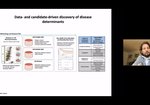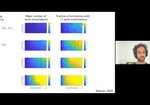
Columbia University's Zuckerman Institute
Columbia’s Zuckerman Institute is dedicated to sharing the extraordinary research of our scientists with broad audiences.
https://zuckermaninstitute.columbia.edu/
https://zuckermaninstitute.columbia.edu/
Simulation & Projection of COVID-19 in the US: What Is the Metapopulation Model and How Does it Work? Can the Model Project Future Outcomes of the Disease?
By
Columbia University's Zuckerman Institute
FEATURING
Jeffrey Shaman
By
Columbia University's Zuckerman Institute
FEATURING
Jeffrey Shaman
2,223 views
May 27, 2020
Simulation and Projection of COVID-19 in the US
Dr. Shaman described his group’s work on ...
read more ↘ developing a metapopulation model that describes the transmission dynamics of SARS-CoV-2 and its application for inferring key epidemiological characteristics and projecting future outcomes. His team built a metapopulation network model, representing 375 cities in China during the period of January 10-23. The model separately represents documented and undocumented infections, as well as contagiousness for documented/undocumented infections, outputting various parameters such as transmission rate, latency period, infectious period, relative transmission rate, etc. The stimulations of the model showed that without transmission from undocumented cases, confirmed cases decrease 79%. The model-inference approach identified a 14% documentation rate prior to travel restrictions, and indicates that undocumented infections contribute substantially to COVID-19 transmission. The model was also applied to the United States and made projections with the parameters from the system, as well as projections of COVID-19 cases and deaths as individual states re-open (https://www.medrxiv.org/content/10.11...)
↖ read less
Dr. Shaman described his group’s work on ...
read more ↘ developing a metapopulation model that describes the transmission dynamics of SARS-CoV-2 and its application for inferring key epidemiological characteristics and projecting future outcomes. His team built a metapopulation network model, representing 375 cities in China during the period of January 10-23. The model separately represents documented and undocumented infections, as well as contagiousness for documented/undocumented infections, outputting various parameters such as transmission rate, latency period, infectious period, relative transmission rate, etc. The stimulations of the model showed that without transmission from undocumented cases, confirmed cases decrease 79%. The model-inference approach identified a 14% documentation rate prior to travel restrictions, and indicates that undocumented infections contribute substantially to COVID-19 transmission. The model was also applied to the United States and made projections with the parameters from the system, as well as projections of COVID-19 cases and deaths as individual states re-open (https://www.medrxiv.org/content/10.11...)
↖ read less
Comments 3
Login to view comments.
Click here to Login
Videos






































































































































